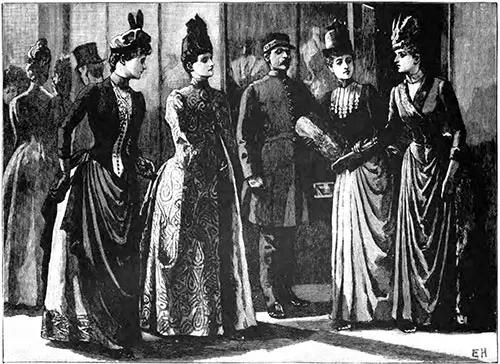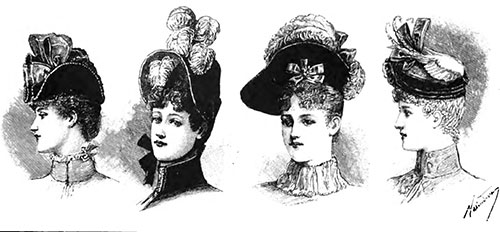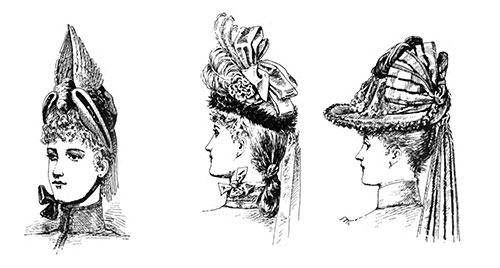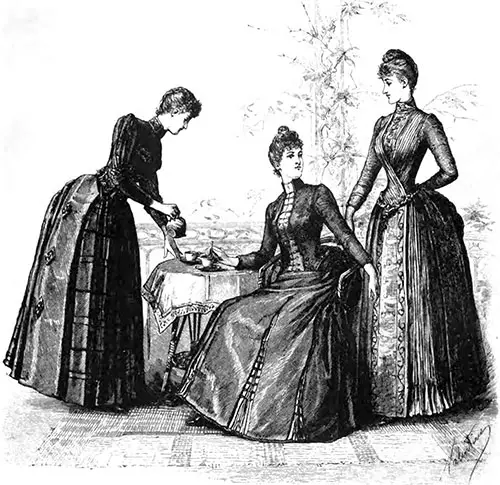London Fashions October 1888
"From women's eyes this doctrine I derive:
They sparkle still the right Promethean fire;
They are the books, the arts, the academes,
That show, contain, and nourish all the world;
Else, none at all in aught proves excellent."
Love’s Labor’s Lost, iv. 3.
The least gallant of the sterner sex would hardly be inclined to dispute that, whether women's influence be assertive or dormant, it exists, and is one of the most powerful levers of the world.
It is her peculiar prerogative to preserve, not only beauty in her surroundings but the love of beauty in humanity; and it is her influence that gives the necessary impetus to many industries which exist principally, if not entirely, for her.
That this is so, widens not only her sphere of usefulness, but enlarges her duties. If she suddenly develops a liking for a certain make of lace, busy hands find employment in meeting the demand; and whatever lead she directs fashion to take, that it follows, and trade prospers thereby.
At the present moment, woolen garments of all kinds are in the ascendant, and silk is more used with wool than alone, while, as a fact, the majority of gowns for day wear are made without any admixture of silk at all. Yet, under all these disadvantages, a great effort is being made to revive the silk industries in England and Ireland, and it rests a very great deal with the women of Great Britain whether the effort is to be crowned with success.
Silk Industry
There is this point in its favor, that, when the silk industries in England were in the height of their prosperity, the Spitalfields looms were producing just the kind of silks that are finding favor now, although, maybe, under different names: lutestrings, à la modes, brocades, satins, paduasoys, ducapes, and velvets.
In the time of Anne and the first two Georges 50,000 persons depended on silk-weaving, but there came evil times. The work is neither easy nor very profitable. To make a single inch of velvet the shuttle has to be thrown 180 times, the treadles the same.
Sixty times the wire is inserted and withdrawn, and sixty times the knife cuts along the breadth, and sixty times the heavy beam is pressed against the chest of the worker. Even forty years ago the 25,000 looms were at work.
Of late a renewed effort is being made with the Leek silk, and the textures of the brocades are excellent and full of promise. To succeed, they must be as good and as cheap of their kind as can be had in the market.
Tailor-Made Gowns
Tailor-made gowns find favor with Englishwomen at most periods of the year, but more especially when autumn is undeniably upon us. The illustrations of Messrs. Redfern's models indicate some of the principal novelties in style.

Tailor-made Costumes for Autumn Wear.
The dress of green Venetian cloth, worn by the figure on the extreme right (above), has panels of gold braid, and is trimmed with otter-fur, which goes better with green than with any other shade.
The bodice is double-breasted, with a vest of pale pink cloth, discovering no fastening whatever. The roll collar is of otter, and the fur crosses the front of the bodice.
The drapery is straight and is so well shown in the picture that no further description is necessary. Simple as this is, it needs skillful cutting, and is a dress that might be worn on almost any occasion during the autumn and winter and could hardly be seen without being noted for a certain most undeniable good style.
The costume on the left side is made of fawn cloth, the petticoat has a deep braiding in gold, and the drapery is so caught up that it shows to perfection. The bodice is of the habit form.
The new point about it is the double waistcoat, which is made of white cloth, buttoning down the front to the point, but the upper one comes hardly below the bust and is braided all over with gold and brown. There is a roll collar, which seems now to be an inseparable part of tailor-made jackets and bodices.
The hats worn with both of these costumes are worthy of special notice. One is made of a piece of the green cloth used for the dress, which stands up well, is most deftly twisted, and is surrounded by a band of otter.
The other has a brim of coarse straw, with a full soft crown of the cloth. In the hand, it seems flat, and it draws its inspiration from the head-gear worn under Tudor kings and queens, but, in lieu of any handsome ostrich-feathers, two quills are thrust through the side, of the dark brown tone of the dress trimmings. No two of these hats would seem to be made alike—each suits the face of the particular wearer.
Mantles are to be either very short, merely reaching to just below the waist, or sufficiently long to cover the skirt; a carriage-wrap or traveling-cloak must be of this latter kind, and the most fashionable are made like the one illustrated, of very fine brocaded cloth, in two shades of the same color, or some neutral tint and black.
In the present instance, the cloth is of a delicate grey, with the [line patterns of a darker shade. It is a particularly graceful and comfortable shape, fitting well on the shoulders.
The bonnet worn with it is of the same fine cloth pinked round, the full velvet front resting on the head, while the cloth stands up well in a decided pouf.
Quite a contrast, and well suited to a girl or young married woman, is the coarse-ribbed cloth jacket, handsomely braided in black and gold Russian braid on the cuffs and shoulders and trimmed with handsome passementerie ornaments.
It would look well either for riding or driving and may be made up in any kind of cloth or in any color that might be required.
Autumn Fashions
There is this autumn a decided preference shown for cloth of a firm, close texture; loosely-woven materials are going out. While women are in so many ways adopting masculine styles for their garments, they are borrowing the notion from them of having firm, solid, and durable materials.
The new cloths for dresses, mantles, and jackets, are close-woven and very beautiful in their range of coloring. Fawns. greys, dark blues, and greens are well worn, but the browns with a red tinge in them are the new idea.
Flame is a general name, but, in truth, it is more the dull brownish-red tint which a coal has when the red is fading into black.
Terracotta has given place to a more pinky red, and many of the winter clothes are made of this tone speckled with white; other colors, such as greys, cardinals, and indigo-blue, are also speckled, and they are often accompanied by the same grounds, with white stripes, in which are flecks or splashes of color, sometimes of many hues.
Silk is introduced with great effect into these woolens, which under this aspect become very costly, but only a few yards are required to give importance to a dress.
The more simple manner in which the idea is carried out is the introduction of uniform silk stripes on the silk ground, about an inch wide, with a woven edge, so that the stripes look exactly as if a piece of ribbon had been laid on. However, the more elaborate patterns have broad silk fancy stripes, often shaded, and these form very handsome panels.
Borders are another and distinctive feature in the new winter woolen goods. In the ribbed stuffs these are often formed by the introduction of a line of gold or silver between the ribs of the material; some fabrics have checked borders, but amongst the newest are the cashmerienne designs of handsome lines in red and gold tones.
Occasionally these borders are sufficiently wide to cover half the depth of the skirt, in frisé patterns of black or color, which at a distance look like cross-stitch. Red is too becoming not to be much worn, and red cloth dresses with white waistcoats, and red panels in other colored dresses, are to be seen in pretty well every large and fashionable gathering.
Hats and Bonnets

New Hats and Bonnets for Autumn Wear.
The new millinery (hats and bonnets) in our illustrations gives the latest novelties provided by Mme. Phoebe Smith, of Regent Street. The hats and bonnets show a return to the large shapes which our grandmothers affected when the century was young.
Velvet is the favorite material, and brilliant contrasts prevail. Purple velvet is lined with orange. Double points appear above the forehead in the Directoire hat with the rounded side-brim, all edged with cord and surmounted by huge loops of ribbon.
The broad-brimmed hat, irregular in form, is rendered specially becoming by the bow of narrow ribbon which rests on the hair, and the ostrich-plumes which seem to frame the brim.
The toque-shaped hat is improved by the brim rising immediately above the face in a point; the arrangement of the feathers at the back recalls the cap of Morens. The crown is quite open, and there are quills at the side; hitherto, open crowns have been confined to bonnets.
The other Directoire hat, of green velvet, shades the face well, is bordered by a ruche of black lace and feathers, and has all the striped ribbon bows at the back.
A closed shape is well suited to the Catogan style of hair-dressing, with the feather - trimmed brim, and long streamers at the back. It is quite as much a bonnet as a hat and has a bright yellow rosette at the side.
The Empire bonnet of blue velvet is lined with yellow and trimmed with yellow velvet. The narrow blue velvet strings are tied at the side.

Red Felt Bonnet. | The Catogan Bonnet. | Green Velvet Directoire Hat.
Our other illustration (above) is a red felt bonnet (on the left), trimmed with black velvet and black birds. Note how curiously the wings are placed above the face, and what height they give to the bonnet. It has been a long time since millinery fashions have made so many new departures.
That a useful garment need not of necessity be ugly is proved by the new water-proof cloaks, covered with striped moire and all sorts of woolen cloths, chiefly checked. They are made in the most fashionable shapes and are so arranged now as to be fit for everyday use if only care were taken that they are well ventilated.
As the bad weather approaches, to be forearmed will save many a good skirt. The ordinary woolen petticoats are now covered with a fancy water-proof tweed, outside and in, to the depth of half a yard, and so defy any amount of mud or damp grass.
Women are learning to wear gaiters, which are now made to match any dress, and come well up the leg, meeting the vamp of the boot. They are neat-looking but require to be carefully cut in order not to add. to the size of the foot.
Boots and shoes are made to more thoroughly cover the foot or the leg, as the case may be: a move in the right direction, as proper support is thus given to the foot.
Autumn and Winter Gowns
The prevailing make in autumn and winter gowns will be gleaned from the three sketched at Messrs. Debenham and Freebody's (below). The colorings are new and original.
The slate-colored cashmere has panel stripes of rich brocade shot with orange, the bodice having a kilted vest of the same, the tones accentuated by handsome shaded passementerie with which it is bordered at the waist.

Visiting, Travelling, and Afternoon Costumes.
The visiting-dress is plaid silk—myrtle-green and Venetian red—with the Directoire redingote, made of plain myrtle silk, fastened at the back with strap and buckle, and trimmed with shaded bead passementerie and ornaments to match.
The more simple dress for traveling is a fine olive cloth, with biscuit cloth introduced, and knots of gold cord. The olive bodice has a biscuit vest with more knots of gold cord.
Gloves
It is by no means an easy matter to find a good-looking and reliable glove at a fair price. Suedes are yielding to French kid, because, I am inclined to think, they are such a perishable material that women can no longer afford them.
If anything tempted us to remain faithful to old favorites it would be some excellent Suede gloves now being sold at moderate prices by the London Glove Company in Cheapside, and in such a large variety of colors that almost any gown may be matched.
They can be had with many buttons, or mousquetaire with none, which is really the proper style for this class of glove, which should be ruffled up the arm.
Another kind which looks well for the country wear as well as town has braid points. Silk gloves have long ceased to be fashionable, though thousands of women wear them; and the great drawback that they will wear out at the fingers has been tried to be met in many ways.
Last spring, kid tips were introduced, but they were apt to part company with the silk, and so were undesirable. Now a better plan has been hit upon by the London Glove Company: the tips of the fingers are protected by rows of stitching, which receive the brunt of the heavy wear falling on that part of the glove, and they are easier to slip off.
For a long day's traveling, the Tyrol gloves are very comfortable; they do not compress the hand. It is quite possible to write in them; and, moreover, they wash well.
The best plan of carrying this out is to wash them thoroughly on the hand, leave the soap on, pull them well into form as they dry, watching them so that they do not harden, which can be prevented by judicious pulling.
Johnstone, Violette, “October Fashions,” in The Woman’s World, Cassell & Company, Limited, London, Paris, New York & Melbourne, Volume I, No. 12, October 1888, p. 565-568.
Note: We have edited this text to correct grammatical errors and improve word choice to clarify the article for today’s readers. Changes made are typically minor, and we often left passive text “as is.” Those who need to quote the article directly should verify any changes by reviewing the original material.
